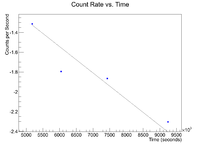Difference between revisions of "PAA ASH"
| Line 1: | Line 1: | ||
=SAMPLE C= | =SAMPLE C= | ||
| − | In this sample, it was found that there was a peak at 881 +/- | + | In this sample, it was found that there was a peak at 881 +/- 0.89 keV |
Below the progressive decay of the energy peak can be seen: | Below the progressive decay of the energy peak can be seen: | ||
| Line 13: | Line 13: | ||
[[File:Sample C 881keV plot.png|200px]] | [[File:Sample C 881keV plot.png|200px]] | ||
| − | Root gives a half life of 30.2 +/- 4.4 days. After the half life and the energy peak were found, I used rad search and the interactive chart of nuclides to determine that the most likely physics event that occurred would be a single neutron knockout of 85-Rb, with the most intense energy line being 881.6 keV. The half life of 84-Rb is 32.8 days, which falls within one standard deviation of the half life that ROOT gives. There are two other decay peaks at 1016.2 keV and 1897.8 keV. Since these are higher energies, the efficiency of the detector must be taken into accounts when comparing the relative intensities of these lines. | + | Root gives a half life of 30.2 +/- 4.4 days. After the half life and the energy peak were found, I used rad search and the interactive chart of nuclides to determine that the most likely physics event that occurred would be a single neutron knockout of 85-Rb, with the most intense energy line being 881.6 keV, which is within one standard deviation of the observed line. The half life of 84-Rb is 32.8 days, which falls within one standard deviation of the half life that ROOT gives. There are two other decay peaks at 1016.2 keV and 1897.8 keV. Since these are higher energies, the efficiency of the detector must be taken into accounts when comparing the relative intensities of these lines. |
=SAMPE YYY= | =SAMPE YYY= | ||
Revision as of 16:59, 28 June 2016
SAMPLE C
In this sample, it was found that there was a peak at 881 +/- 0.89 keV
Below the progressive decay of the energy peak can be seen:
The activity of this line was plotted against time since the irradiation. The plot is shown below.
Root gives a half life of 30.2 +/- 4.4 days. After the half life and the energy peak were found, I used rad search and the interactive chart of nuclides to determine that the most likely physics event that occurred would be a single neutron knockout of 85-Rb, with the most intense energy line being 881.6 keV, which is within one standard deviation of the observed line. The half life of 84-Rb is 32.8 days, which falls within one standard deviation of the half life that ROOT gives. There are two other decay peaks at 1016.2 keV and 1897.8 keV. Since these are higher energies, the efficiency of the detector must be taken into accounts when comparing the relative intensities of these lines.
